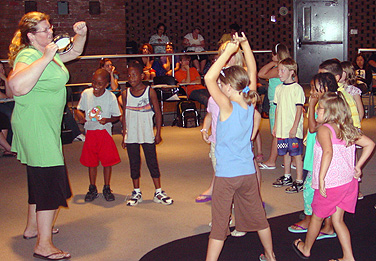News
Music education institute strikes a chord

Jennifer Bailey leads students from Holmes Elementary School in a demonstration class as part of the Summer Music Education Institute. Photo: REBEKA SORGE
Music educators from Western New York and as far away as Korea, Germany, Costa Rica and the United Arab Emirates spent part of their summer at UB learning how to improve the way they teach music to young children.
UB’s Summer Music Education Institute, now in its 11th year, aims to show educators how children learn when they learn music, rather than how to teach the structure and elements of music. The strategy is based on a theory developed by former UB faculty member Edwin Gordon that teaches music through “audiation”–Gordon’s term for “the ability to hear and comprehend music in the mind.” Gordon’s Music Learning Theory shows music teachers the best way to develop students’ tonal and rhythm audiation.
The summer institute allows participants to hone their classroom skills while learning how to put Gordon’s theory to use.
“It’s not only the theory that the teachers get to study. They get to put it into practice,” explains Maria Runfola, associate professor of learning and instruction in the Graduate School of Education who oversees the music education concentration of the doctoral program in elementary education.
The summer sessions, which were held in July on the North Campus, began every morning with musicianship classes to help the 52 participants develop a rich repertoire of songs in various tonalities and meters, as well as a listening and speaking vocabulary of tonal and rhythm patterns. Participants received instruction in Gordon’s Music Learning Theory and broke up into small groups for peer teaching.
The afternoon sessions began with an hour of creative movement, in which participants learned how their students can use this movement as an initial step to rhythm learning. At the same time, this technique can improve the teachers’ own rhythm abilities, Runfola notes.
In addition to lectures, musicianship classes and break-out sessions to work on technique, those taking part in the program attended hour-long demonstration classes that featured singing and chanting, colorful props and creative movement. These activities, Runfola says, help children pay attention to the feelings, form, style and rhythm created by certain pieces of music. By focusing on music without words, the children respond naturally to what they hear, helping them to better understand the elements of music, she says.
During one such session, children from Holmes Elementary School in the Town of Tonawanda learned about rhythm by tapping wooden sticks against their shoulders and knees. The teacher, Jennifer Bailey, a certified faculty member of the Gordon Institute for Music Learning, then taught them the “resting tone” -- the note that sounds like the musical phrase has come to a resolution -- by singing and passing a ball to each student. The student then caught the ball and sang the resting tone.
The institute has had a profound effect on participants.
“It changes who they are as teachers,” says Runfola. “We hear it over and over. Once you see what young children are able to do musically when you use Gordon’s theories, a transformation takes place in one’s teaching and you can never go back to traditional approaches.”
Others agree.
“It changed the trajectory of my life,” says Heather Holden, a teacher at Holmes Elementary who arranged for the children from Holmes to attend the demonstration class.
Many educators have brought ideas they learned in the institute into their school districts. And the summer institute continues to expand. Enrollment has increased steadily each year and is expected to continue to grow. Many participants, along with others who have heard about the institute, enroll in GSE’s programs in music education, which continue the focus on Gordon’s Music Learning Theory.
“We’re going to make even more of a contribution as this young professoriate, well-trained in research and in Gordon’s music learning theory, enters the field of music education,” says Runfola.
Moreover, the summer sessions also have built lasting relationships among Runfola, guest clinicians who teach in the institute and music teachers who attend the sessions.
“It’s the high point of our year,” says Runfola.

Reader Comments